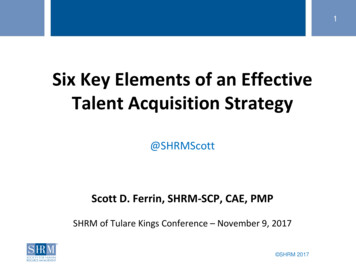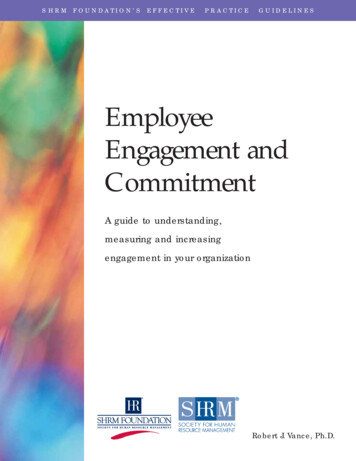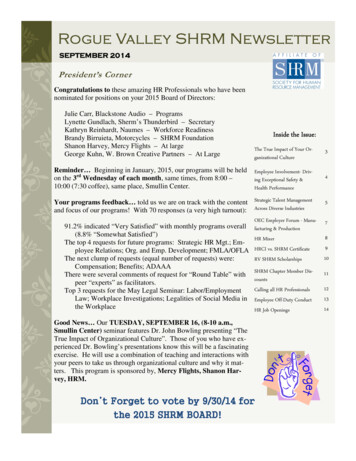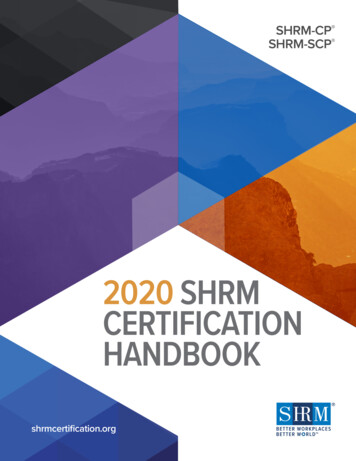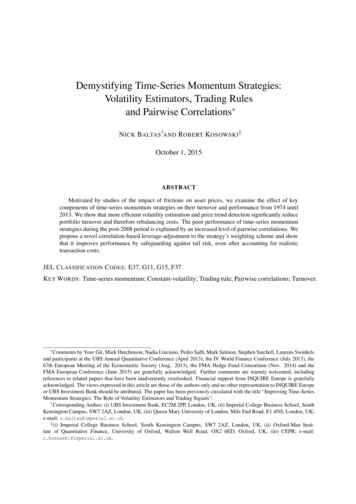
Transcription
Demystifying Sales HiringA COLLABORATIVE STUDY BY METTL & SHRM INDIA, 2017How HRs can build awinning sales team?3-FACTOR MODEL TO FIND THERIGHT COMPETENCIES FOR YOURWINNING SALES TEAM
Executive SummaryIn today’s complex world, organizations are changingat a rapid pace. Business leaders across industryverticals want nothing but fast and sustainable growth.This results in huge targets for the back-bone ofany organization, which is the Sales Team. Thesepressures are complemented with highly demanding,technology-empowered and information-rich customerswho are redefining traditional selling. For many salesorganizations, selling has evolved from traditionalproduct pitches to a more customized, highly tailored,and/or customer-focused solution pitches.depending on whether they sell to businesses (B2B)or end-customers (B2C). Few others have classifiedsales job roles basis the media that is used to conductthe sales like tele-sales, field sales, channel sales, andfranchisee sales.An important block in ensuring organizations grow at thedesired rates and sell to these new-age customers is bybuilding winning sales team.Before deep-diving into identifying the right set of skillsand motivations for various industries and sales teams,we conducted a survey which led us to discover:The sales representatives, who are the face of anyorganization, need to be a step ahead of their customersto close the deal and meet business objectives at thesame time. This challenge of building winning salesteam isn’t a simple task. HRs who are assigned thishumongous task are struggling to meet the expectationsfrom their sales leaders.Since sales is a complex job, it might come acrossas difficult to fully understand every sales role in itsentirety. Even the job description varies drastically acrossorganizations and at times even within organizations.From the person selling a shoe in a store to a personselling complex aircraft solutions – all are at the end ofthe day “Salespeople”.HRs and sales leaders need to understand whichcompetencies make their top performers successful.These competencies then must be replicated to resolvemultiple issues faced by HRs across employee life cycleranging from shortlisting the right people out of theshrinking talent pool to hiring the best-fit candidate fororganization’s unique requirements to on-boarding theseright people quickly to keeping them motivated andensuring regular trainings for better productivity as wellas returns on investments.There have been attempts by others to understandand break down sales job roles in the past. Some havelooked at the approach that a salesperson takes (his orher personal style) when dealing with clients and closingtransactions. These studies have classified salespersonsas Hunters and Farmers. Others have classified them01 Demystifying Sales HiringThe purpose of this research is to address (and to alarge extent simplify) this diversity to not only betterunderstand the nature of sales across industries aswell as buyer type and medium of selling, but alsoidentify key factors that lead to success in various salessituations.Do people decisions(hiring, onboarding,training) affect salesperformance?How important arepeople decisions acrossindustry, company size,and buyer type?What is the impactof smarter peopledecisions on salesteam performance?How can HRs identifythe right competenciesto augment their peopledecisions?Below are some of the key findings which wereuncovered from our survey of 1600 sales professionalsacross industries in the 2016-17:1. Hiring the right talent emerged as one of the top 3growth drivers to improve the performance of salesacross industry, company size, buyer type (B2B/B2C).2. Teams invest inadequate time to know why their topperformers are successful in their organization.3. High performing teams focus more on competencybased hiring & analytics and performance forecastingwhen compared to low performing managers.4. Many organizations don’t use simple tools like onlineassessments and structured interviews for hiring theright sales executive effectively.These insights provided enough evidence to the fact thatHRs must not only spend adequate time in identifyingcritical competencies for their unique requirements butalso use well researched tools to ensure they do this atscale using state of the art technology.
Further to the survey, in-depth interviews across 65 sales professionals were conducted andbelow are some of the top insights of our study:1Rethinking Sales Job Roles: It’s about What to sell, How to selland Who to sellWe are all selling. But, do we all sell same product through similar process to same buyer? The answer is NO.As a result, for taking right people decisions with the objective of enhancing sales performance, it is critical todeepen your knowledge about your unique sales job roles. Mettl-SHRM India’s 3 factor model with focus onOffering Complexity (What you sell), Process Complexity (How you sell) and Buyer & Environment Sophistication(Who you sell) can simplify this task of demystifying large number of sales roles into 27 logical categories.2Sales Behavior Competencies Blueprint: Personal Attributes,Work Orientation, Interpersonal Skills and Leadership SkillsWith challenging customer expectations, sales team can no longer afford to be laid-back. Top performing teamsare the ones which know the right set of behavior for their unique requirements. Basis our research, we haveoutlined a blueprint for sales behavior competencies for each of the 27 categories. These behaviors can beclassified into Personal Attributes, Work Orientation, Interpersonal Skills and Leadership Skills.3Sales Aptitude Competencies Blueprint: Cognitive andCommunication SkillsSalespeople are the face of any organization. They are the ones who know your customers and the ones thatyour customers are familiar with. Smart selling is more about building smart sales team. Cognitive aptitude andcommunication skills are must have ingredients for smart sales team. This report identifies the unique set ofcognitive and communication skills for each of the 27 logical salespeople segments.4Adopt state-of-the-art technologies to build winning teamsWinning sales teams must be built by ensuring that all stakeholders involved in hiring/training evaluate usingidentified critical competencies. This can be achieved if state-of-the-art technology solutions are adopted atevery stage of people decisions. For hiring right talent, recruiters must dissect the incoming talent throughcompetency-based assessments and hiring managers must adopt these in structured interviews. Similarly, foreffectively training the existing workforce, identifying the individuals’ strengths and weaknesses through pretraining assessments is as important as ensuring training yields desired outputs through post-training evaluation.Demystifying Sales Hiring 02
Table Of ContentsExecutive Summary . 01Introduction . 04Past Attempts At Similar Research .05The Role Of Hiring In Redefining Sales .06Key Objectives Of This Research . 07Rethinking Sales Job Roles: It’s About What To Sell, How To Sell And Who To Sell .08Assumptions Made For The Usage Of The 3-Factor Model .133-Factor Model For Sales Job Roles . 15Competency Framework For Sales Job Roles . 17Understanding The Competency Framework . 18Sales Behavioural Competencies Blueprint . 18Sales Aptitude Competencies Blueprint . 22Adopt State-Of-The-Art Technologies To Build Winning Sales Teams .23Additional Insights And Learnings .24Conclusion .25Appendix .2603 Demystifying Sales Hiring
Introduction“Shifting the sales team to meet the growingchallenges”Sales wasn’t always this complicated. It used to bea person-to-person affair, built on handshakes andskilled pitches delivered in person or over copper wiredtelephones. Though the foundational sales skills ofyesteryear are just as relevant to sales success today,the context of selling has been transformed by theforces of technology, globalization and the ubiquitousconnectivity of a Wi-Fi-enabled workplace. We all knowthat sales training and sales effectiveness have been acornerstone of many organizations’ strategies to increaserevenues and drive efficiency. As markets continue togrow and evolve in complexity, learning leaders need toalign their organizations’ initiatives with the selling skillsneeded to succeed in dynamic environments.So, are companies setting up theirsales personnel for success?Are they targeting salescompetencies that reflect the 21stcentury business landscape?It’s not only the skills that salespeople need for successin today’s market. The sales cycle has also transformed,with customers now being able to educate themselvesand access reams of information before even meetinga salesperson. Buyers have taken the reigns on thesales process and move through the cycle somewhat ontheir own terms and pace. This change has altered thecustomer engagement strategies that salespeople mustmaster; they need to be able to adapt to each customerto account for where that customer is along the pathto closing a sale, and position products and servicesaccordingly.Demystifying Sales Hiring 04
Past Attempts At Similar ResearchSince sales is a complex job, it is difficult to fullyunderstand every sales role in its entirety. There havebeen attempts by others to understand and break downsales job roles in the past.Some have looked at the approach that a salespersontakes (his or her personal style) when dealing withclients and closing transactions. These studies haveclassified salespersons as hunters (the ones who chaseafter new accounts and ones whose purpose in thesales chain is to gather leads and garner interest amongclients), farmers (these are the ones who nurture andgrow relationships with clients and mine them for morebusiness over time) and closers (the ones who persistand chase after the client to ensure that the deal isclosed). [1]Some other attempts at categorizing sales job roles havealso considered salespersons selling to the governmentas being a separate species in themselves. [4]Finally, sales processes have also been categorizedbasis the media that is used to conduct the sales. [5]This classification typically includes telesales, field sales,channel sales, franchise sales etc. As the names suggestit classifies salespersons basis their most commonlyused method for generating initial contact with a client allthe way to closing deals.The purpose of Mettl-SHRM’s research is to address(and to a large extent simplify) this diversity to not onlybetter understand the nature of sales across industriesand experience, but also identify key competencies thatlead to success in various sales situations.Others have tried to classify sales roles as Inside andOutside Sales to indicate how the salesperson follows upon leads and closes deals. While Inside sales refers to asalesperson working entirely from the office and usingvarious media such as telephones to cold-call potentialclients, Outside sales refers to salespersons who largelyspend their time out of the office, meeting clients inperson. [3]The process of conducting sales and the qualitiesa salesperson needs to possess, have been furtherclassified based on whether he or she is selling toan individual consumer or to a business. Retail andEnterprise sales (also sometimes known as Direct sales)require salespersons to possess an entirely different setof skills and qualities to be able to accomplish the result. While retail sales might be more transactional andshort-term in nature, enterprise sales or selling directly toa business requires more consultative selling skills andthe ability to grow and nurture long term relationships. [2] 1 Sales Executive: A Comparison of Competencies Between Different Business Categories. Aspiring Minds. different-business-categori-02 Hunters vs. Farmers {Infographics} of Sales Personnas. Greg Klingshirin, SalesLoft. rsvs-farmers-sales-personas-infographic/3 Different Types of Sales Jobs: What will your responsibilities be? Matthew Cook. SalesForce Search ies-Be4 B2B vs B2C Sales, Similarities and Differences. Greg Dunne. Mansfield Sales Partners. ces5 B2B vs B2C Sales, Similarities and Differences. Greg Dunne. Mansfield Sales Partners. ces05 Demystifying Sales Hiring
The Role Of Hiring In Redefining SalesRESPONDENT INSIGHTSTo examine the above issues in greater detail, Mettl along with SHRM India conducted a study to examineorganizations’ approach to identifying and developing sales workforce. Over last 8 months, 1600 sales professionalscompleted a confidential survey reporting their approach to managing and improving sales team performance. Someof the key findings of the survey analysis are:57%of respondents feel thathiring the right talent is oneof the top 3 growth driversto improve the performanceof sales across industries.MANAGER INSIGHTSFocus on competency-based hiring:High performingteams73%Low performingteams56%ORGANISATION INSIGHTS1.3X better performance45%of respondents (whothink hiring is critical)don’t know why theirtop performers aresuccessful.Focus on analytics and forecasting:Low performingteamsHigh performingteams64%54%1.2X better performanceUse competency-based interviews60% of surveyed organizationsdon’t use assessments for hiringthe right sales executive.High performingorganisationsAllorganisations46%22%2.1X better performanceMore details about the survey results are presented in Mettl’s Sales Performance Study 2017.Demystifying Sales Hiring 06
Key Objectives Of This ResearchAbove insights along with Mettl’s experience over theyears, intrigued the research team into deep-diving intoHR’s key challenge of building high-performing salesteam which delivers business goals while adapting withchanging customer needs.They undertook an extensive qualitative validationexercise by conducting 65 detailed telephonicconversations with salespersons in various industrieswho have recent as well as considerable experiencein that industry. Interviews were conducted with twosample groups. The groups differed in the number ofyears of experience they had within a industry. Theslightly less experienced group had experience withinan industry that ranged from 3 to 7 years whereasthe salespersons in the more experienced group hadexperience ranging from 8 to 17 years.07 Demystifying Sales HiringThese interviews were conducted with two-fold objective:1To rethink large number of sales jobroles – This involved an exercise of understandthe similarities and differences across the broadspectrum of sales job roles such that we can arriveat a common set of competencies as well as somecritical competencies that might be required forcertain sales job roles2 To develop a sales competency frameworkwhich can be practically used by HRs acrossindustries to identify the right set of competenciesfor their unique requirements
Rethinking Sales Job Roles: It’s AboutWhat To Sell, How To Sell And Who To SellWe are all in sales. Some are doing traditionalsales while other are doing non-selling sales.– Daniel Pink in his book on “To sell is Human”An important follow-up question to this thought is that “Are we all similar and interchangeable?”. Anyone would say– NO! To understand any sales job role, it is critical to understand what product or service is the salesman selling, towhom is he/she selling, is he selling it over counter or on telephone, is he selling for the first time or to repeat buyers,is the sale happening in small volume or large batch and many more.The process of demystifying the complex and large number of unique roles into an all-encompassing tool has been along and arduous one. Basis preliminary internal discussions, as well as the validation exercise with industry experts,a 3-factor model (Fig. 1) was put together that is comprehensive and considered salespersons as well as buyers (alsoreferred to as consumer, end user, client, purchaser, etc.) as being the key elements to fully understand the salesman’srole. What to Sell? (Product Complexity) How to Sell? (Process Complexity) Who to Sell? (Buyer & Environment Sophistication)Fig. 1: 3-factor sales modelHOW TO SELL?WHO TO SELL?(Process Complexity)(Buyer & EnvironmentSophistication)Need established or notConsultativeSolution known or notSales cycle timeMulti-stagePotential transaction valueNo.of decision makersTransactionalBrand strengthPremiumMidBasicTarget buyer profile(Purchasing/decisionmaking power; Basic/luxury needs)Typical sellingenvironmentSimpleMid-ComplexComplexWHAT TO SELL?(Offering Complexity)Extent of offering detailsrequired by buyer before making decisionLevel of complexity in understanding &explaining the offering detailsDemystifying Sales Hiring 08
Let’s understand these snippets in brief WHAT TO SELL? (Offering Complexity)Pertains to the offering being sold by the organization. It can be a product, a service, a solution or acombination of each of them. The extent of offering details required by buyer before making a purchasedecision and level of complexity of the offering decides what the salesperson needs to know / do toeffectively sell it to the maximum audience considered.HOW TO SELL? (Process Complexity)Defines the process / methodology adopted by a salesperson to sell an offering. It can be simple innature, involving a one-time face-to-face interaction with a customer, or a series of transactions involvingmultiple decision makers and multiple interactions. The more complex the selling process becomes; themore effort will be required by a salesperson to effectively sell it.WHO TO SELL? (Buyer & Environment Sophistication)Refers to the buyer of the offering and the environment in which sales usually takes place. Thebackground, affordability, need as well as the knowledge of the offering a buyer has can require asalesperson to adjust his/her interactions to convince them that they are buying the right product. Often,selling environment also influences the interactions between buyer and seller.The above factors are critical to be considered to effectively capture the essence of most sales job roles.Understanding each of the 3 parameters in detail is essential before understanding their interplay (Fig 2).Fig. 2: Definition of Critical ParametersWHAT TO SELL? (Offering Complexity)Example: Pen, soap,sim card, ceiling fan,cement, pendriveSimpleComplex Example: ERP solution,warehouse automationsolution, aircraft engine,defence trucksWHAT TO SELL? (Offering Complexity)Example: One-timeinteraction sales; needestablished; pull exists;low value of transactionTransactionalConsultativeExample: Multipleinteractions over longsales cycle; need to beestablished; solutionmatches need; push; highvalue of transaction; highswitching costWHAT TO SELL? (Offering Complexity)BasicExample: Farmer,villager, admin person09 Demystifying Sales HiringPremiumExample: CXO, Director,High SEC individual
1. Offering ComplexityOne of the most influential parameters, the complexityof the offering answers the question: What to Sell?This dimension refers to a combination of the factors thatinfluence the sale of a particular product or service or acombination of both, in the market; what its features are,whether they are easily understood, and whether it willinvolve a low or high-volume sale among customers.No matter what the sales person does or doesn’t do,this factor to a large extent determines who they interactwith, the tactics they must use, the process that will befollowed etc.For the purposes of our current research study, theproduct has been defined as any physical or virtualproduct or service that will be consumed, used,experienced etc. by the end user that it is meant for. Thissuggests that the product could be anything that rangesfrom what might be sold in retail shops to even software,which might be purchased, paid for and experiencedvirtually.We further divided this dimension into 3 parts:SIMPLE OFFERINGA simple offering is easily understood by a customer aswell as easy to explain by a salesperson. The need for theoffering is clearly established, i.e. whether the customerreally needs it or not, is known. No prior informationgathering or time investment in terms of understanding aproduct is required. Simple products and services, havelittle or no ambiguity or risk associated with them, have alot of information readily available for the consumer anddo not require a salesperson to explain or handhold thecustomer on how to use them.A few examples of the industries that sell simple offeringsare FMCG/FMCD, Gems and Jewellery, Telecom, ITHardware and Textiles.MODERATELY COMPLEX OFFERINGProducts and services which require a consumer to investsome time and energy to understand the various optionsavailable to them before arriving at a final decision arelikely to be moderately complicated in nature. While thisinformation and research may be done independently(i.e. through browsing the internet or other sources forinformation), one may also end up seeking help fromsalesperson. However, the overall risk and ambiguityassociated with such an offering is slightly higher thanwhat is true for simple offerings and much less than whatmight be the case with complex offerings. Since thesedays’ information is readily available, consumers usuallyend up doing their own research before approaching asalesperson to educate them.A few examples of the industries selling such offeringsare Agriculture, Healthcare, Media and Advertising, RealEstate, Hospitality, Automobiles and Electronics.COMPLEX OFFERINGComplex products/services are those that involveconsiderable ambiguity and risk and may have featuresthat are not easily understood. Even though informationabout their features may be readily available, they maynot be presented in a format that can be easily consumedby the end user. Therefore, the salesperson may berequired to explain the product in detail, and providesupport and information about its use, even after thetransaction is closed.This makes it essential for a salesperson of a complexoffering to be more sophisticated in his/her approach,even when trading in retail sales. Since the buyer ofsuch an offering may need extensive information,a salesperson must have an extensive domainunderstanding.A few examples of industries selling complex offeringsare Banking and Financial Services, Education andTraining, IT Solutions and Heavy-Duty Infrastructure.An important point to note and understand is that certainproducts can move from being complex to semi-complexor simple over a period, once their usage becomes morewidespread and commonplace.For e.g. Mobile devices when first introduced in late 1990sand early 2000s were considered complex in nature. Notall features were easily comprehended and there wasconsiderable ambiguity about the various brands sellingthem. However, over period mobile devices have come tobe considered as semi-complex product.Demystifying Sales Hiring 10
2. Process ComplexityAnother critical parameter is the complexity of the sellingprocess. It answers the question: How to Sell? It refersto the aspects of a typical sale that happens between acompany and its customer, which mainly correspondsto the time that will be taken to sell a product, thenumber of persons/teams involved in the same and thestages involved in getting the customer to finally buythe offering. It considers few factors such as the typicaltransaction value of an offering, its brand value andwhether the transaction is a repeat/one-time case. Themode/channel of selling the product or service also has abearing on the process complexity of the offering.Selling process also refers to the interaction that takesplace between the seller and the buyer before the buyercloses the transaction by paying for the offering andaccepting it.This factor has been split into 3 types:TRANSACTIONAL PROCESSA sales process that involves a transaction madebetween very few stakeholders, or is something that endswithin a short period of time (i.e. typically doesn’t requiremore than 1 interaction between the buyer and the seller).The need for a product sold in such kind of transactions isusually well established, and the salesperson has readilyavailable solutions for the customer’s problems. Thedecision makers involved in such kind of a process arealso minimal.There might be no intention of the salesperson forfollowing up or maintaining a long-term relationship withthe client.MULTI-STAGE/TACTICAL PROCESSA sales process where a transaction requires multiplerounds of interaction between the buyer and the seller.Multi-stage transactions can be a result of the natureof the product (for e.g. purchasing a house/propertywhere the deal is not closed for years at a time becauseof the time required to fully deliver the product etc.) orthe process (for e.g. taking out a loan that may requiremultiple rounds of visiting the loan provider etc.)The need for a product/service sold in such kind oftransactions might not be known/established, and the11 Demystifying Sales Hiringsalesperson might not have readily available solutions fora customer’s problems.The decision makers involved in such kind of sales canbe more than people involved in a transactional sale. Theprocess requires multiple rounds of interaction becauseof the nature of the amount of regulation or the leverageto negotiate for the best deal.CONSULTATIVE PROCESSA sales process involving a transaction where theconsumer only has a vague understanding of his/her needs and may not have a clear understanding ofwhat product or service is likely to suit them best. Insuch cases, the salesperson plays a critical role in notonly understanding and clearly establishing the client’sneeds, but in also educating the client about the varioussolutions that might be available and what amongst themis likely to be most appropriate for their requirements.This process requires the salesperson to haveconsiderable knowledge and understanding of themarket and competition to increase the odds of beingable to win and close the deal. This type of process maytypically be associated with large enterprises or whendealing with the government or public/political bureaus.Since the consumers do not know what they need orwhat will suit their needs best, selling requires both adefinition of the problem as well as the solution. Thesales transaction can be of a high value and there maybe high-level switching costs associated with the same.The decision makers involved in such kind of a processare usually more in number, especially people from thesenior management in several organizations.
3. Buyer And Environment SophisticationThis parameter answers the question: Who to Sell?Who a salesperson sells to, makes a huge difference inhow the 3 factors of the model change and interact witheach other to give us a better understanding of the keycompetencies required for a salesperson.The pull vs. push nature of products, market dynamicsetc. could also influence the overall interaction betweenthe consumer and the seller, since they add layers ofnuances, rather than forming the foundation for definingand classifying sales interactions.This can be further split into 3:BASICPREMIUMSuch a customer belongs to a high socio-economicbackground and is generall
Demystifying Sales Hiring A COLLABORATIVE STUDY BY METTL & SHRM INDIA, 2017 . to closing a sale, and position products
